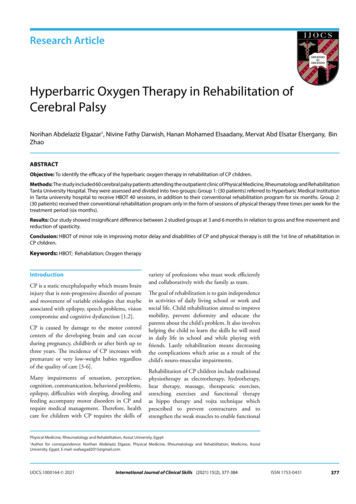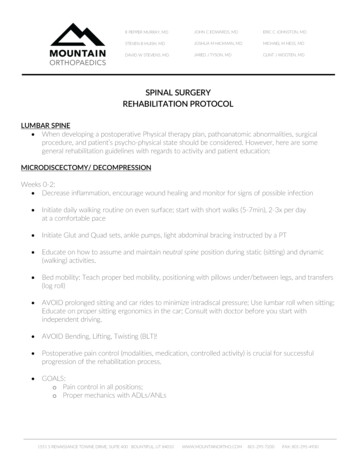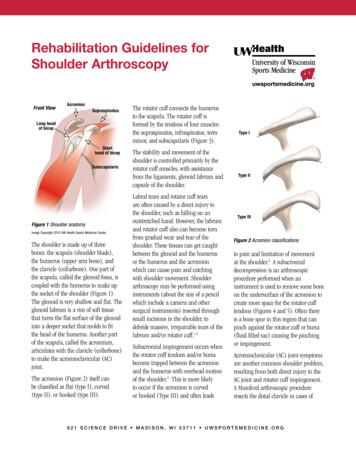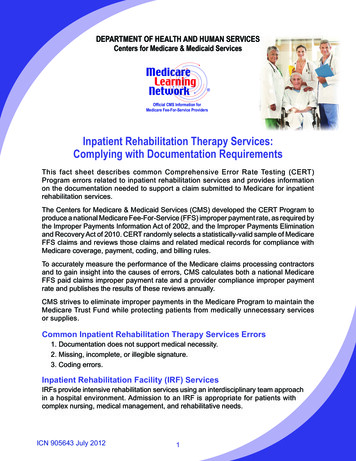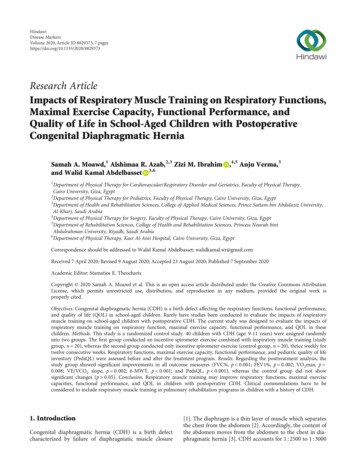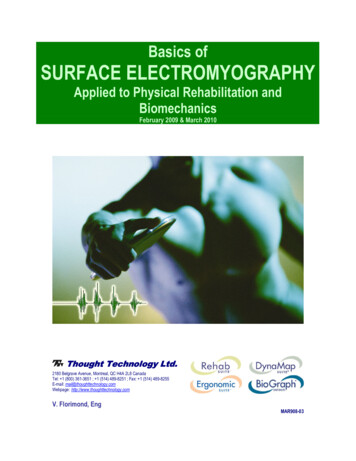
Transcription
Basics ofSURFACE ELECTROMYOGRAPHYApplied to Physical Rehabilitation andBiomechanicsFebruary 2009 & March 2010Thought Technology Ltd.2180 Belgrave Avenue, Montreal, QC H4A 2L8 CanadaTel: 1 (800) 361-3651 ; 1 (514) 489-8251 ; Fax: 1 (514) 489-8255E-mail: mail@thoughttechnology.comWebpage: http://www.thoughttechnology.comV. Florimond, EngMAR908-03
Thought Technology Ltd – SEMG Applied to Physical Rehabilitation & Biomechanics i
Table of ContentsIntroduction. 1Skeletal Muscle Properties . 2Types of Fibers . 2Types of Contractions . 2Types of Contributions to a Movement. 3Muscles Involved in Movements . 5Shoulder . 5Elbow. 5Wrist . 6Hip . 6Knee . 7Ankle. 7Detection of SEMG signal . 8A/D Converter (Encoder). 8Amplifier (Sensor) . 9MyoTrac Series: A/D Converter Amplifier . 10Surface Electrodes & Cables . 11Typical Electrode Placements. 13Skin Preparation . 13General Recommendations for Positioning Electrodes and Cables. 13SEMG Electrode Sites – Front View . 14SEMG Electrode Sites – Back View. 15SEMG Electrode Sites – Side View. 16The SEMG Signal. 17Physiological Basis of SEMG. 17Signal Processing . 17SEMG Artifacts. 21Impedance Check . 23Signal Analysis. 24Normalization Methods . 25Summary of Recommendations . 25Examples of Use . 26SEMG Biofeedback. 26SEMG & Muscle Fatigue Monitoring . 31SEMG & Joint Motion. 32SEMG in Range of Motion Assessment . 33SEMG in Muscle Testing. 33SEMG with Isokinetic Dynamometers . 34SEMG with MyoRack System . 35SEMG for Fitness Training. 35SEMG in Ergonomics. 36About Research . 38A Typical Procedure . 39Preparing the Examining Room . 39Thought Technology Ltd – SEMG Applied to Physical Rehabilitation & Biomechanics ii
Electromagnetic Interferences . 39Electrostatic discharges. 39Preparing the Examinee. 39Connecting the Sensors to the Encoder. 40Starting a Session. 41Before You Start . 41Checking the electrode impedance (MyoScan-Z users only). 41Zeroing MyoScan-Pro Sensor. 42Recording . 43Bibliography. 44Books . 44Articles . 45Web Sites. 45Thought Technology Ltd – SEMG Applied to Physical Rehabilitation & Biomechanics iii
IntroductionThis document was written to assist you in using surface electromyography for biomechanicsapplications and physical rehabilitation.Surface ElectroMyoGraphy (SEMG) is a non-invasive technique for measuring muscle electricalactivity that occurs during muscle contraction and relaxation cycles.“Electromyography is unique in revealing what a muscle actually does at any moment duringmovement and postures. Moreover, it reveals objectively the fine interplay or coordination ofmuscles: this is patently impossible by any other means” (Basmajian, “Muscles Alive, TheirFunction Revealed by Electromyography”).Surface electromyography is widely used in many applications, such as:- Physical Rehabilitation (physical therapy/physiotherapy, kinesitherapy, chiropractic andorthopedics)- Urology (treatment of incontinence)- Biomechanics (sport training, motion analysis, research)- Ergonomics (studies in the workplace, job risk analysis, product design and certification)SEMG is clinically indicated for: Biofeedback Relaxation Muscle re-education Treatment of incontinenceSEMG is also commonly used in psychophysiology.“Psychophysiology involves the scientific study of the interrelationships of physiological andcognitive processes” (Mark S. Schwartz, 2003).Whereas applications addressed here mainly focus on the biomechanical aspects of muscleactivity, psychophysiology focuses on muscle activity in response to emotions. The assessmentand treatment goals of these two approaches, and consequently their use of SEMG, aredramatically different.Therefore psychophysiology is not addressed in this document, for the sake of clarity and in orderto avoid misunderstandings in the field.After you have become familiar with the key concepts, it is strongly recommended that you dohands-on training, before using them on a real examinee. As simple it can be, it still requirespractice.Note: This document is not intended to replace scientific and clinical literature. A bibliography ofreferences is provided at the end.Thought Technology Ltd – SEMG Applied to Physical Rehabilitation & Biomechanics 1
Skeletal Muscle PropertiesSEMG may be considered a “seductive muse because of its apparentsimplicity” (De Luca). SEMG can be easily misinterpreted, so it isimportant to have a good understanding of what the signal indicates.However, in order to understand SEMG, one must first understandmuscle.This chapter reviews the main anatomical and physiological conceptsthat must be kept in mind when interpreting SEMG.Types of FibersSkeletal muscles contain two main types of fibers: Slow-twitch fibers (type I) and fast-twitch fibers(type II).Type II fibers are further divided in two groups: Type IIa and IIb (sometimes a third group ismentioned: type IIx).Type I fibers are small, fire slowly and use the aerobic metabolism to produce energy. They canwork for long periods and are very resistant to fatigue.Type IIa fibers are intermediate fast-twitch fibers. They are of a medium size and can use bothaerobic and anaerobic metabolisms to produce energy. They fire faster than the Type I fibers andcan generate faster contractions. They can work for no more than 30 minutes, as they fatiguefaster than the Type I fibers.Type IIb fibers are the classic fast-twitch fibers. They are big and use the anaerobic metabolism toproduce energy. They fire faster than the type IIa fibers but are able to work only for a few minutes.Their proportions in the muscle vary with the type of muscle and the condition of the examinee(injured, normal or athlete).Types of ContractionsThere are three types of contractions: Concentric: The muscle shortens. This happens when the tension is greater than theload. Isometric: The muscle stays the same (no movement). The tension is equal to the load. Eccentric: The muscle lengthens. The tension is less than the load.Thought Technology Ltd – SEMG Applied to Physical Rehabilitation & Biomechanics 2
Types of Contributions to a MovementMuscles are divided in three groups according to their contribution to a movement: Agonist muscles: The first movers, they initiate the movement; they generate most of theforce. Synergist muscles: Assist the agonist muscles; they generate less force but contribute tothe control of the movement. Antagonist muscles: Act in opposition to the movement; they provide a stabilizing forceduring the movement.Examples of agonist/antagonist NISTTricepsLatissimus DorsiTrapezius/RhomboidsErector SpinaeGlueteus MaximusAdductorsHamstringsTibialis AnteriorNote that the contribution of a muscle, and consequently its assignment to a group, depends on themovement performed. Each movement has its antagonistic movement, which moves the limb in theopposite direction:o Flexion Extensiono Protraction Retractiono Abduction Adductiono Plantarflexion Dorsiflexiono Inversion Eversiono Left lateral flexion (spine and neck) Right lateral flexiono Pronation Supinationo Left rotation (spine and neck) Right rotationo Elevation Depressiono Lateral rotation (extremities) Medial rotationElbow flexion: the biceps is the agonist andshortens (concentric contraction), which makesthe elbow flex. The triceps is the antagonist. Itlengthens (eccentric contraction) and its onlyfunction is to stabilize the movement by providinga force in opposition to the biceps and gravity.Elbow extension: similarly, the triceps is nowthe agonist and shortens, which makes theelbow extend. The biceps then becomes theantagonist and stabilizes the movement byproviding a force in opposition to gravity andthe triceps.Thought Technology Ltd – SEMG Applied to Physical Rehabilitation & Biomechanics 3
A movement occurs when the agonist and synergists contract while the antagonist is relaxing.However, gravity can also play a proactive role and be the greatest contributor to the movement, interm of force. For instance, in the case of a right lateral flexion of the back in standing position, theagonist muscle (right lumbar paraspinal) only initiates the movement, gravity generating most ofthe force.Therefore the antagonist muscle (left lumbar paraspinal) is more involved than the agonist, but stillplays its role of control of the flexion and is not the initiator of the movement: a muscle can onlypull, it cannot push.Right lateral flexionLeft lumbar paraspinalpulling down to controlthe movementGravity effectRight lumbar paraspinalslightly pulling down toinitiate the movementRight lateral flexion of the back in standing positionThe movement pattern can be altered by muscle imbalance (agonist vs. synergists or antagonist),or disturbance in the sequence of firing.Movement pattern disturbances may find their origins in the following phenomenons: Hyperactivity: when a muscle contracts too early, too fast or too much. Hypoactivity: when a muscle contracts too late, too slow or not enough. Hypotonicity: a diminution of the muscle tone marked by a diminished resistance topassive stretching.Hypertonicity: excessive muscle tone marked by an increased resistance to stretchingand heightened reflexes. Substitution: normal muscles take over a parallel one, to protect it and unload it wheninjured, weak or fatigued. Note that a substitute muscle may also become fatigued andbecome hypotonic (muscle shutdown). Co-contraction: co-contraction is the abnormal symmetrical activation of homologousmuscles during asymmetrical movements, such as rotation or lateral bending, or moregenerally the over-activation of the antagonist muscle in order to protect the agonist (alsocalled muscle bracing; pain is usually observed). Spasm: a spasm is a sudden, involuntary contraction of a muscle or a group of muscles.Thought Technology Ltd – SEMG Applied to Physical Rehabilitation & Biomechanics 4
Trigger-point: a trigger-point is a hyperirritable spot in the muscle, a spasm at the cellularlevel. Emotional arousal (or stress): can increase the tonus of a muscle and change timingand coordination.Muscles Involved in MovementsShoulderMovementInvolved MusclesAbductionSupraspinatus (initiates motion)Deltoid (continues motion)Biceps brachiiMovementInvolved MusclesFlexionCoracobrachialisAnterior deltoidPectoralis majorBiceps brachiiLateral RotationPosterior deltoidInfraspinatusTeres minorMovementInvolved MusclesAdductionLatissimus dorsiTeres majorTriceps brachiiCoracobrachialisPectoralis minorExtensionPosterior deltoidLatissimus dorsiTeres majorTriceps brachiiMedial RotationAnterior DeltoidLatissimus dorsiPectoralis majorSubscapularisTeres majorElbowMovementInvolved MusclesMovementInvolved MusclesFlexionBiceps brachiiBrachialisBrachioradialisPronationPronator teresPronator quadratusAnconeusBrachioradialisExtensionTriceps brachiiAnconeusSupinationSupinatorBiceps brachiiThought Technology Ltd – SEMG Applied to Physical Rehabilitation & Biomechanics 5
WristMovementInvolved MusclesFlexionFlexor carpi radialisFlexor carpi ulnarisPalmaris longusFlexor digitorum superficialisFlexor digitorum profondusMovementInvolved MusclesRadial Deviation (Abduction)Extensor carpi radialis brevisExtensor carpi radialis longusFlexor carpi radialisExtensor pollicis brevisExtensionExtensor carpi radialis brevisExtensor carpi radialis longusExtensor carpi ulnarisExtensor digitorumExtensor pollicis longusExtensor indicisUlnar Deviation (Adduction)Extensor carpi ulnarisFlexor carpi ulnarisHipMovementInvolved MusclesMovementInvolved MusclesMovementInvolved MusclesFlexionAdductor brevisAdductor longusIliacusPectineusPsoas majorRectus femorisSartoriusTensor Fascia lataeAbductionGemellus inferiorGemellus superiorGluteus maximusGluteus mediusGluteus minimusPiriformisTensor fascia lataeMedial RotationGluteus mediusGluteus minimusTensor fascia lataeExtensionAdductor magnusBiceps femorisGluteus maximusSemimem branosusSemitendinosusAdductionAdductor brevisAdductor longusAdductor magnusBiceps femorisGluteus maximusGracilisPectineusPsoas majorLateral RotationAdductor brevisAdductor longusAdductor magnusBiceps femorisGemellus inferiorGemellus superiorGluteus maximusGluteus mediusObturator externusObturator internusPiriformisQuadratus femorisSartoriusThought Technology Ltd – SEMG Applied to Physical Rehabilitation & Biomechanics 6
KneeMovementInvolved MusclesFlexionBiceps membranosusSemitendinorusMedial emitendinorusExtensionRectus femorisTensor Fascia lataeVastus intermediusVastus lateralisVastus medialisMovementInvolved MusclesDorsiflexionExtensor digitorum longusExtensor hallucis longusPeroneus tertiusTibialis anteriorMovementInvolved MusclesEversionExtensor digitorum longusPeroneus brevisPeroneus longusPeroneus tertiusPlantarflexionFlexor digitorium longusFlexor hallucis longusGastrocnemiusPeroneus brevisPeroneus longusPlantarisSoleusTibialis posteriorInversionFlexor digitorum longusTibialis anteriorTibialis posteriorMovementInvolved MusclesLateral RotationBiceps femorisAnkleThought Technology Ltd – SEMG Applied to Physical Rehabilitation & Biomechanics 7
Detection of SEMG signalThe SEMG signal generated by the muscle fibers is captured by the electrodes, then amplified andfiltered by the sensor before being converted to a digital signal by the encoder. It is then sent to thecomputer to be processed, displayed and recorded by the Infiniti software.MuscleFibersElectrodes ( cable) Computer / InfinitiSoftwareProcessor/MonitorA/D Converter (Encoder)Thought Technology’s A/D converters are called “encoders”.o ProComp5 Infiniti has 2 channels (A and B) sampling at 2048 samples per second and 3channels (C to E) sampling at 256 samples/second.o ProComp Infiniti has 2 channels (A and B) sampling at 2048 samples per second and 6channels (C to H) sampling at 256 samples/second.o FlexComp Infiniti has 10 channels (A to J) sampling at 2048 samples per second.ProComp5 InfinitiProComp InfinitiFlexComp InfinitiTelemetric card forwireless transmissionThe sample rate (for instance, 2048 samples per second) is the number of measures (samples)per second taken from the continuous signal (analog signal). In this case, the analog signal is theSEMG signal captured by the electrodes and amplified by the sensor. The series of samplesconstitutes the digital signal.A raw SEMG signal has to be sampled at a minimum of 1000 samples per second and an RMSSEMG signal has to be sampled at a minimum of 32 samples per second (see definition of rawSEMG and RMS SEMG in section “The SEMG signal”).Thought Technology Ltd – SEMG Applied to Physical Rehabilitation & Biomechanics 8
Amplifier (Sensor)Thought Technology’s EMG sensors are differential amplifiers. This means that whatever electricalactivity is common to both sites is rejected, and what differs is amplified. It allows the rejection ofthe common mode between electrode pairs.The EMG sensors for ProComp5, ProComp and FlexComp Infiniti are:o MyoScan (SA9503M) and MyoScan-Z (SA9503Z) which amplify and output raw SEMG.o MyoScan-Pro (SA9401M) which amplifies raw SEMG and converts it to RMS SEMG.MyoScan (SA9503M)MyoScan-Z (SA9503Z)MyoScan-Pro (SA9401M)Note: MyoScan-Z is an EMG sensor with built-in impedance checkTherefore, MyoScan and MyoScan-Z sensors are used on channels A and B of ProComp Infinitiand ProComp5 Infiniti and all channels of FlexComp Infiniti, whereas MyoScan-Pro is used onchannels C to H of ProComp Infiniti and on channels C to E of ProComp5 s256samp/s256samp/s MyoScan orMyoScan-ZMyoScan-ProProCompMyoScan p/s256samp/s ABCDEFGHIJ 2048samp/sMyoScan orMyoScan-ZMyoScan-ProThought Technology Ltd – SEMG Applied to Physical Rehabilitation & Biomechanics 9
MyoTrac Series: A/D Converter AmplifierThought Technology also manufactures devices dedicated to SEMG:o MyoTrac Infiniti has 2 built-in raw SEMG sensors sampled at 2048 samples/second.o MyoTrac3 has 2 built-in RMS SEMG sensors sampled at 20 samples/second.MyoTrac3MyoTrac InfinitiMyoTrac Infiniti can also, in certain configurations, have two electro-stimulation channels (NMES).These devices are usually used in muscle rehabilitation and incontinence treatment.Thought Technology Ltd – SEMG Applied to Physical Rehabilitation & Biomechanics 10
Surface Electrodes & CablesThe silver-silver chloride electrodes are the part of the instrument that is in contact with the skin.They make electrical contact between the skin and the sensor. The electrodes are either directlyconnected to (or “snapped on”) the sensor, or indirectly connected via an extender cable. ThoughtTechnology provides various types of electrodes.T3402M – Triode electrode (single use): The triode should be your first choice. Itcan be snapped directly on the sensor head, which makes it very easy to use andquick to position. The signal is then amplified right on the muscle site, whichdramatically increases the SNR (Signal-to-NoiseRatio) and therefore limits pollution of the SEMGsignal by surrounding electromagnetic fields and movement artifactsgenerated by wires being pulled.The distance between the electrodes is optimal for avoiding orlimiting muscle crosstalk.However, its size does not make it suitable for long and thinmuscles with great deformation while contracting, or for widerplacements. In this case, the choice of another electrode typeshould be considered.T3404 - Single strip electrodes (single use): Thesingle strip electrodes are theperfect choice for long and thinmuscles that do not offer enoughspace on the belly for a triode,and/or for muscles requiring aslightly wider distance betweenactive electrodes. Here thereference electrode is placed between the active ones, which reduces the widthof the electrode area in comparison to a triode and prevents them from peeling off. An EMGextender cable (T8720M) must be connected between the electrodes and the sensor.These electrode strips can also be cutapart, which gives total freedom in termof placement. It is ideal for a widerplacement or in order to put thereference electrode at a different place.T3425 - UniGel electrodes (pre-gelled,single use): The UniGel electrodes providetotal freedom in term ofplacement. Their smallsize also allows placementon very tiny muscles (suchas SCM). They are notattached together, whichThought Technology Ltd – SEMG Applied to Physical Rehabilitation & Biomechanics 11
prevents them from moving on the skin when positioned on muscles with great deformation whilecontracting. These electrodes are pre-gelled and so do not require the addition of conductive gel,which reduces the time of preparation for this type of electrodes. An EMG extender cable(T8720M) must be connected between the electrodes and the sensor.SEMG Vaginal Probes - T6050 / SEMG Rectal Probes - T6051(re-usable for a single client only): These probes are used formonitoring of the pelvic floor muscles. They feature a verticalelectrode configuration to ensure measurement along the directionof the muscle group. The T-bar ensures repeatability ofmeasurement with respect to orientation and depth placementbetween uses. The small overall size and bulb configuration enablecomfortable and secure seating of the sensor in a number of clientpositions including walking, standing or prone.SEMG/Stim Rectal St-Cloud - SA9571 / Vaginal FemelexProbes - SA9572: The St-Cloud/Femelex probes are usedvaginally or in the rectum to stimulate or sense the pelvicfloor muscles. The same electrodes may be used forsensing or stimulating the pelvic floor muscles.Thought Technology Ltd – SEMG Applied to Physical Rehabilitation & Biomechanics 12
Typical Electrode PlacementsSkin PreparationProper skin preparation is important to get a good signal and avoid artifacts.Before applying electrodes, make sure the skin surface is clean and dry:Abrade the skin with an abrasive cream, such as NuPrep, to remove dead skin.Alternatively, you can also clean skin with an alcohol wipe and let it dry, but this is not asefficient as the abrasive cream.If necessary, shave excess body hair.General Recommendations for Positioning Electrodes and CablesIf you use single electrodes with an extender cable, start by snapping theelectrodes on the cable connectors. Once the electrodes are positioned on theskin, this action may be more difficult or uncomfortable for the examinee.It may be recommended to put conductive electrode paste or cream (such as Ten20) onthe center of electrodes (grey area only) before applying them to the skin. Only a smallamount is necessary.Place the active electrodes first (blue and yellow) on the examinee. The active electrodes shouldbe placed in line with the muscle fibers, unless specified otherwise. Then place the referenceelectrode (black connector) anywhere on the body.Make sure the electrodes are placed firmly on the skin and that there is good contact between theskin and electrodes.Electrode SiteActive electrodesReference electrodesImmobilize the cables with tape, straps or an elastic band to prevent them from being pulled orshaken.The following pages show electrode placement on the different body areas. For clarity, only theactive electrodes are shown.Thought Technology Ltd – SEMG Applied to Physical Rehabilitation & Biomechanics 13
SEMG Electrode Sites – Front ViewHead and omastoid (SCM)5.C4 Cervical Paraspinals er TrapeziusLower TrapeziusInfraspinatusLatissimus DorsiT2 ParaspinalsT8 ParaspinalsT10 ParaspinalsL1 ParaspinalsL5 ParaspinalsRectus AbdominalAbdominal ObliqueInternal ObliqueSerratus AnteriorPectoralis MajorArm20.21.22.23.24.25.26.27.Anterior DeltoidLateral DeltoidPosterior DeltoidBiceps BrachiiTriceps BranchiiBrachioradialisWrist FlexorWrist teus MediusGluteus MaximusHip AdductorHip FlexorVastus Medialis Oblique (VMO)Vastus Lateralis (VL)Quadriceps FemorisMedial HamstringMedial GastrocnemiusLateral GastrocnemiusSoleusTibialis AnteriorThought Technology Ltd – SEMG Applied to Physical Rehabilitation & Biomechanics 14
SEMG Electrode Sites – Back ViewHead and omastoid (SCM)5.C4 Cervical Paraspinals er TrapeziusLower TrapeziusInfraspinatusLatissimus DorsiT2 ParaspinalsT8 ParaspinalsT10 ParaspinalsL1 ParaspinalsL5 ParaspinalsRectus AbdominalAbdominal ObliqueInternal ObliqueSerratus AnteriorPectoralis MajorArm20.21.22.23.24.25.26.27.Anterior DeltoidLateral DeltoidPosterior DeltoidBiceps BrachiiTriceps BranchiiBrachioradialisWrist FlexorWrist teus MediusGluteus MaximusHip AdductorHip FlexorVastus Medialis Oblique (VMO)Vastus Lateralis (VL)Quadriceps FemorisMedial HamstringMedial GastrocnemiusLateral GastrocnemiusSoleusTibialis AnteriorThought Technology Ltd – SEMG Applied to Physical Rehabilitation & Biomechanics 15
SEMG Electrode Sites – Side ViewHead and omastoid (SCM)5.C4 Cervical Paraspinals er TrapeziusLower TrapeziusInfraspinatusLatissimus DorsiT2 ParaspinalsT8 ParaspinalsT10 ParaspinalsL1 ParaspinalsL5 ParaspinalsRectus AbdominalAbdominal ObliqueInternal ObliqueSerratus AnteriorPectoralis MajorArm20.21.22.23.24.25.26.27.Anterior DeltoidLateral DeltoidPosterior DeltoidBiceps Brachii
- Physical Rehabilitation (physical therapy/physiotherapy, kinesitherapy, chiropractic and orthopedics) - Urology (treatment of incontinence) - Biomechanics (sport training, motion analysis, research) - Ergonomics (studies in the workplace, job risk analysis, product design and certi

